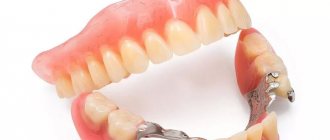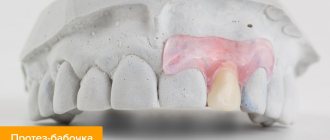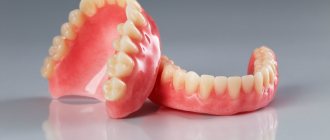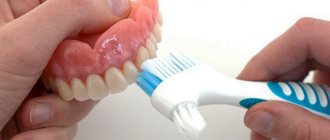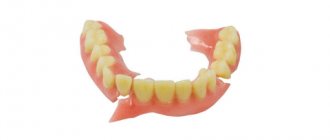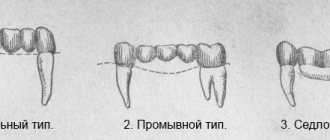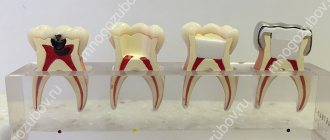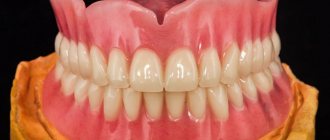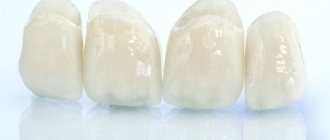Chief editor of the site:
Snitkovsky Arkady Alexandrovich
Chief physician of the professorial dentistry “22 Century”, dentist, orthopedic dentist
Author of the article:
Scientific team of dentistry “22 Century”
Dentists, candidates and doctors of medical sciences, professors
Removable prosthetics is an alternative to fixed prosthetics if most or all teeth are lost, and there are contraindications to the installation of fixed prosthetic structures.
Removable dentures are often the only way to restore the chewing function of the jaws and make the patient’s smile aesthetically pleasing. Despite the skeptical and even ironic attitude of many patients towards this method of solving the problem, today dental orthopedics offers options for removable prosthetics that will suit the vast majority of patients .
Creation and installation of various prostheses: what are the stages and how long will it take?
Article navigation
- Stages of prosthetics
- - reorganization
- — photometry
- - casts
- - choice of prosthesis model
- — design and planning
- — creation of a prosthesis
- - first fitting
- — fixation of the structure
- - education
- How long does it take for production?
- Manufacturing time for fixed dentures
- Production time for removable devices
- Care
- QUESTIONS
Question for a specialist
Modern dental prosthetics are affordable and multivariate solutions for restoring the aesthetics of a smile and the function of chewing. In preparation for restoration, the patient goes through several preparatory stages, which include choosing a doctor and clinic, selecting a prosthetic technique and preliminary treatment - they can take from a couple of days to several months. Detailed materials about this can be found on our website. The creation and installation of structures also consist of various procedures. What stages are involved in direct dental prosthetics, and in what time frames the structures are made, we will describe in detail in this article.
Preparation and care
Indications for removable dental prosthetics are partial or complete edentia - loss of chewing units. As was said, this happens most often due to a lack of vitamins, genetic factors, and insufficient care. However, the procedure itself also requires the patient to be attentive to the doctor’s recommendations. In order for the manipulations associated with removable dental prosthetics to go quickly and painlessly, you need to undergo tests, cure existing inflammations of the oral cavity, and get rid of colds and infections. If you have a fever, malaise, or poor health, intervention cannot be performed! Hypothermia and physical exertion should be avoided. The gums should be calm - then it will be possible to take an accurate impression that requires minimal correction. After completion of removable dental prosthetics, even more thorough oral care is required. The point is not only in the psychological aspect associated with the presence of a foreign body, but also in the gradual increase in loads on the gums and jaws. This is the only way to complete the adaptation process as quickly as possible. What other advice do dentists usually give after removable dentures?
- At first, it is not advisable to visit a bathhouse, sauna, or experience significant physical activity. You should avoid traveling by plane.
- It is important to take care of the body and strengthen the immune system. Simple anaerobic training in the fresh air will help with this.
- You need to eat right. Having fresh meat, dairy products, vegetables and fruits will help you quickly adapt to the new state.
- You need to brush your teeth with a soft brush and a gentle gel-based paste, without abrasive ingredients. This will avoid scratches and deformation of the prosthesis.
- When removed, dentures should be stored in water with the addition of special instant tablets. They kill microbes and help maintain favorable microflora.
IMPORTANT! Any person should visit the dentist at least once a year. Those who have had removable dental prosthetics need to see the clinic twice a year.
How to install prostheses - stages of prosthetics
After the patient has been diagnosed and is fully prepared, prosthetic procedures begin, which will result in the restoration of lost teeth and a smile transformation. All of them are painless and do not take much time. Below is a description of all stages of dental prosthetics.
Sanitation of the oral cavity
It is a mandatory preparatory stage before prosthetics. Sanitation aims to improve the overall health of the oral cavity and reduce the bacterial load. It includes treatment of living teeth from carious lesions, elimination of inflammatory gum diseases, if necessary, depulpation - removal of the nerve from the tooth, canal filling, as well as a complex of professional hygiene. All this is necessary to create favorable conditions1 before future prosthetics.
PROSTHETICS WITH 6 OSSTEM IMPLANTS FROM RUB 220,000.
Complex implantation Osstem (South Korea) with delayed loading after 4-6 months.
Call now or request a call
For more information about dental treatment before installing dentures, read the article “Preparation for dentures: steps and procedures for successful dental restoration and long-term denture service.”
Photometry
A series of photographs of the patient's face and jaw are taken from different angles. The photo captures the patient's face with and without a smile, with jaws closed, in a relaxed state and with an open mouth. This is necessary to visually assess changes in occlusion, facial symmetry caused by missing teeth, as well as to record the patient’s “before” appearance. Later, the final result of the prosthetics will also be recorded in the photo and will determine the “after” result.
Taking impressions of the jaws
To create an accurate design, first complete impressions of the upper and lower jaw with the defect area are formed on a special pliable mass. If teeth are restored with complete edentia, then impressions of the gums are made. With their help, the base of the prosthesis and the structure itself are formed, taking into account the bite. For this purpose, devices such as analyzers and face bows are needed. They help to identify the parameters of bite and jaw closure - occlusion, which is of great importance for functionality and organic integration of the structure into the oral cavity.
This way, all the anatomical features of the patient will be taken into account - they are unique for each person. The impressions are sent to a dental laboratory, where a dental technician will evaluate the features of the prosthetic bed, the location of the defect, and take into account the shape and size of adjacent teeth.
Choosing a prosthesis model, teeth shape and color
Based on the diagnostic results, the doctor advises the patient several prosthetic options suitable for his clinical case. The shape and color of the teeth are immediately selected, harmoniously combined with facial features and skin tone. The choice can be made using special palettes, where possible options are presented, or on the monitor screen (if provided) - that is, in digital format. For example, through special software - we will discuss it below.
Digital Design and Planning
Some modern clinics, which have advanced methods of planning and creating dentures, offer their patients to see their future smile in advance and finally decide on their choice. For this purpose, digital smile design technology is used – Digital Smile Design. It allows, based on computed tomography data, to take into account all the anatomical nuances of the patient’s oral cavity even before making the prosthesis and create an artificial structure indistinguishable from natural teeth.
Thanks to the ideal selection of the shape of the teeth and jaw as a whole, taking into account the relationship and proportions of the face, the patient will receive an individually designed prosthesis. The principles of the “golden ratio” and “beauty mask”, embedded in computer modeling, allow you to correct your smile, creating truly harmonious and natural designs.
Creating a prosthesis in a dental laboratory
In the dental laboratory, the impressions obtained are transferred to plaster models - exact copies of the patient's jaws. And on their basis, with the help of special equipment and from various materials, prosthetics are already created. It is possible to manufacture a structure from both acrylic and expensive and durable zirconium dioxide using robotic equipment. It all depends on the type of prosthesis and its purpose.
The construction is manufactured by a dental technician, and an orthopedic surgeon controls the production process, monitors the quality of the parts produced, the accuracy of the transferred parameters and the convenience of future structures.
Today, the equipment of advanced dental laboratories allows us to produce both comfortable removable dentures, as well as crowns, bridges, and complete fixed appliances secured to implants. Most of them are created not manually, but using robotic equipment, including high-precision milling machines, CAD/CAM systems2, high-tech software, 3D printers, high-temperature ovens and more.
OPERATIVE PROSTHETICS WITH ACRYLIC PROSTHETICS - from RUR 180,000.
Re-prosthetics with an acrylic bridge on a metal frame (all included) up to 12 units.
Save RUR 30,000. Call now or request a call
Read about new technologies that can speed up the production of dentures and significantly improve their quality in the article “New technologies and prospects for the development of dental prosthetics.”
First fitting and correction if necessary
To finally ensure the accuracy of the manufactured restoration and its convenience for the patient, the first fitting is carried out. The position of the structure in the mouth is not always comfortable the first time. The doctor can correct the design right on the spot or, if necessary, send it back to the laboratory for a more precise fit.
By the way, correction may be required later, after the final installation. This is often necessary if the patient has had no teeth for a long time, and then the work of the masticatory muscles resumes and the bite changes.
Fixation of the structure in the oral cavity
If the prosthesis fits perfectly and does not cause discomfort, the doctor fixes it in the oral cavity. This moment becomes the most pleasant for the patient, as it brings him closer to the expected result. It takes a little time to install a denture. Depending on the type of device, fixation takes from 20 minutes to 3 hours.
To fix dentures, some kind of support is required: this can be the root of a living tooth, reinforced with an inlay or a metal pin, or pre-installed dental implants (artificial analogues of roots made of metal). In addition, the gums serve as support for removable structures - in case there is a need to restore completely lost teeth in a row.
Teaching the patient the correct use of prostheses
After installation, the doctor must give advice to the patient: what to do with the new artificial teeth, how to carefully remove them from the mouth (if the denture is removable), how to properly care for it and what foods to eat so as not to damage the crowns.
New generation dentures
Today, patients considering which dentures are best to have a huge choice of designs made of biocompatible materials created using innovative technologies, for example, using a computer CAD/CAM system. Low-traumatic methods of orthopedic treatment and high quality dentures made of metal ceramics, ceramics and zirconium dioxide allow you to quickly and effectively restore the functions and aesthetics of the dentition, without causing harm to healthy teeth and even prolonging their life. Of course, the price of a new generation of dentures is quite high, but these costs will be fully justified by your new smile, flawless in all respects. Besides, nowadays you don’t have to worry about how dentures look. Orthopedic products made from any materials look natural and aesthetically pleasing, and diction does not suffer from modern dentures. Plus, if any problems arise with the design, you can always contact the same dentistry where it was installed for you, since all clinics, without exception, offer a guarantee on dentures.
How long does it take to make a prosthesis?
The timing of dental prosthetics with permanent structures varies. The process can take 5–7 days to 3–4 weeks. How long it takes to make dentures depends on the size, shape, material used, and the presence or absence of metal fasteners. Production times are strictly individual. The patient should not be upset if he has to wait longer than he planned for new teeth - while the permanent structures are being manufactured, he will be offered temporary templates, the installation of which will take only a few hours.
Complex on 4 OSSTEM implants with delayed loading - from RUB 170,000.
Complex implantation Osstem (South Korea) with delayed loading after 4-6 months.
Guarantee for the doctor’s work - unlimited Call now or order a call
Opening hours: 24 hours a day - seven days a week
To a new life with a bright smile
For many years, doctors at the VivaDent clinic have been providing assistance to Muscovites and residents of the region who need removable dental prosthetics. During this time, we have accumulated a wealth of experience, which we will generously share with every visitor. We are glad that the number of regular customers is growing every day. This suggests that the knowledge and skills of professionals have a high reputation among citizens. Those who have lost one or more elements should not despair: modern removable dental prosthetics will help solve psychological and physiological problems. The kind attitude of the staff, a friendly atmosphere, and the smiles of doctors and nurses are an important factor in the patient’s calm state. This is necessary for successful removable dental prosthetics. We make every effort to ensure that the stay within the clinic is as comfortable as possible for every visitor. Why is it better to use our services for removable prosthetics of the upper and lower teeth?
- The most modern equipment has been installed.
- We use innovative materials.
- We use the latest generation of anesthesia.
- We guarantee treatment without discomfort.
- We draw up an individual treatment plan.
- We have our own laboratory facilities.
- We conclude an official agreement.
- There is a flexible system of discounts.
The process of getting used to new elements is perhaps the most important part of removable dental prosthetics. The skill of doctors, the quality of materials, and the experience of laboratory technicians are not in doubt. Patients will also have to work hard to regain the lost ability to eat any food and smile from ear to ear without a hint of embarrassment. Agree, a significant incentive for removable dental prosthetics! Each employee of the VivaDent clinic treats any patient as a friend, worrying about his problems with all his heart. We will definitely help you return to your usual rhythm with minimal losses. We assure you: after removable dentures, life will sparkle with new colors. If necessary, we are always happy to see every client within our walls, we will provide consulting support, answer any questions, and provide the necessary assistance. Removable dental prosthetics in our clinic will allow you to once again experience all the delights of life, recharge yourself with positivity and give warmth to others!
Approximate production times for fixed dentures
How long it takes to make a dental crown depends on the method of its fixation. Will it be on a natural tooth, a post and an implant?
| Crown material | Production time, in days |
| Metal-ceramic dental crowns | 5–10 |
| Metal dental crowns | 4–7 |
| Ceramic dental crowns | 4–7 |
| Metal-plastic dental crowns | 5–10 |
| Crowns based on zirconium dioxide | 4–5 |
How long work on dental bridges takes depends on the number and type of crowns that are used as part of the bridge. In general, the technician’s work takes 10 days or more.
Installation of crowns on implants within the framework of one-stage implantation protocols (All-on-4, All-on-6 and others) is possible already on the 3rd day after implantation, since the creation of prostheses begins already at the time of planning the operation itself.
Repair (repair) of a prosthesis in case of breakdown
The denture should be cleaned 2 times a day, just like your teeth. At this moment, hold the prosthesis firmly and carefully. Because when the denture is wet, it becomes slippery. At this point, most often, the dentures are dropped either into the sink or onto the floor tiles. And the prosthesis splits.
If the prosthesis breaks, collect all the parts and bring them to the dentist, we will assemble them correctly and securely fasten them. Repair time is 1-2 days. If any part of the prosthesis is lost, the prosthesis is made again.
Please note that we do not repair dentures that were not made by us.
Production time for removable devices
| View | Production time, in days |
| Clasp with hooks | 10–12 |
| Clasp on attachments | from 20 |
| Clasp dental crowns on telescopic crowns | from 20 |
| Nylon | 7–10 |
| Soft plastic | 5–10 |
| Plate and acrylic | 5–7 |
The table shows only the average time for dental technicians to complete work. Depending on the workload, the patient may be asked to complete the work much faster than the stated deadline. However, many dental laboratories operate using the “urgent order” system. Production time can be halved, but at the same time you will pay for urgency.
Why do patients choose us?
- Our patients say that the dentures are easy to use and quickly get used to them;
- If it breaks, we try to repair the prosthesis;
- Adaptation to a new prosthesis in a few days;
- We restore teeth in various clinical situations. View photo examples;
- Experience of specialists in the manufacture of prostheses for more than 20 years;
- Individual approach to each patient;
- Materials and equipment are certified from well-known manufacturers. Czech Republic, Switzerland, USA, Germany;
- Cozy and friendly environment in dentistry;
- We cooperate with qualified dental technicians, which is extremely important for orthopedic dentistry.
Maintenance of installed structures
Patients should remember that caring for artificial teeth is no different from caring for natural teeth. It is very important to brush your teeth daily with toothpaste and a brush, and remove food debris after each meal. With removable dentures, this is a mandatory condition, since food debris between the artificial structures and the gums can cause inflammation.
Read more about caring for installed dentures in the material “How to properly care for removable and fixed dentures so that they last as long as possible.”
In addition, you should not eat too hard foods - nuts, seeds, crackers. Artificial teeth can easily break from excessive pressure.
What designs are used in prosthetics?
In dentistry, various types of prosthetic structures are used, which can be divided into two large groups:
- Fixed: inlays and veneers (microprostheses), dental crowns, bridges and implants. They are used to replace defects in the absence of 1-4 teeth (implants can be used to replace any number of teeth, including those with complete edentia), as well as to restore damaged teeth with intact roots. They are fixed in such a way that only a specialist can remove them.
- Removable: the patient can remove such structures and then install them back on their own. They are used in cases where fixed prosthetics are contraindicated, as well as in the absence of a large number of dental units. The main support of such structures is the gums; they can also partially rest on the teeth remaining in the oral cavity.
YOUR QUESTIONS AND ANSWERS
QUESTION: Is it possible to make a new tooth if only one root remains from the old one? Or in such a situation, just remove the remains? Gera
ANSWER: If the root is preserved, then the tooth can be restored. There may be several options: use a pin or stump inlay for extension, followed by restoration of the supragingival part. The choice of method depends on the initial situation, so you can definitely say which one is suitable in your case after examining and taking a photo of the tooth.
QUESTION: After prosthetics for both jaws, I developed a problem in my upper jaw. I made a puller, the lower jaw fits well, but the upper jaw puts a lot of pressure on the attachment points. When I take off the prosthesis, the pain does not go away for another two days. I went to the doctor to have him loosen it, and now the prosthesis is falling off. Cornet
ANSWER: Dear Cornet, we are very sorry for your situation! First of all, it is important to understand that when installing removable structures, if you have not worn them before, there is an adaptation period. And in many cases it can be quite long and takes 2-3 months. During this time, you need to take out your removable denture only for cleaning after meals, but try to wear it the rest of the time so that the oral cavity adapts. In your situation, the compression of the gums at the attachment site could have been eased slightly, and over time the tissue would have gotten used to it. After the correction, the prosthesis began to fall out, perhaps due to the fact that the specialist was overzealous and removed a little more than necessary. Unfortunately, it is impossible to return the former boundaries of a removable denture - only to make a new one. Alternatively, you can try a special adhesive denture adhesive to improve bonding. It can be bought at a pharmacy.
1Belousov N.N. Time and sequence of stages of complex treatment of inflammatory periodontal diseases // Periodontology. – 2007. 2Razumnaya Z.V. Improving the technology of manufacturing dentures using CAD/CAM systems, 2012.
Author: Chorny S.V. (Thank you for your help in writing the article and the information provided)
Removable dental prosthetics: what is it?
Removable dentures are often the only way to restore the chewing function of the jaws and make the patient’s smile aesthetic.
If the situation allows, the orthopedic dentist suggests that the patient use fixed structures to restore the dentition: bridges, crowns, or prosthetics on implants.
However, it often happens that time is lost, the teeth cannot be returned , implants cannot be installed for some reason, or the patient himself does not have such a desire. In this case, the doctor will most likely suggest removable prosthetics.
As it becomes clear from the definition, the prosthesis can be removed. In cases with removable dentures, this can be done by the patient himself; in case of conditionally removable dentures, this procedure is carried out by a dentist.
In the vast majority of cases, the need to remove the denture arises only during hygiene measures (cleaning teeth and dentures). The rest of the time, both day and night, the patient wears it without taking it off.
Indications for prosthetics
As already noted, prosthetics are recommended to be performed with fixed dentures. Because they are more convenient and reliable. But is it possible to put a removable denture on 1 tooth? Of course, there are practically no contraindications here. The main list of conditions when the need for removable monoprosthetics arises is as follows:
- missing 1 tooth along with the root,
- the natural crown is completely destroyed, but the root is healthy and is being “prepared” for fixation of the stump tab with a crown: during the waiting stage, a removable denture is worn,
- an implant has been installed, but the crown has not yet been fixed on it: the healing (fusion with the bone) of a single implant can last 3-6 months, so a plug is placed on it and the gum is sutured. During this period, a temporary prosthesis is installed for aesthetics and to protect the gums from injury.
The exception is patients with absolute contraindications to fixed prosthetics or implantation. For example, in case of severe diseases of the body, poor blood clotting, intolerance to anesthesia, in childhood, during pregnancy and lactation, the “removal device” is worn for a long time on an ongoing basis.
There are certain indications for installing a removable denture on one tooth, which depend on the type of orthopedic design. Therefore, we will dwell on them in the appropriate sections.
